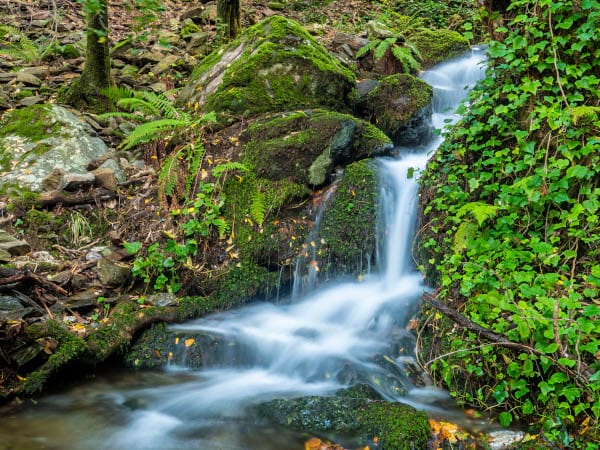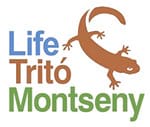Slider 3
Life Tritó Montseny
Un símbol de la natura del Montseny
Subbanner
LIFE15 NAT/ES/000757
Project of conservation of an only species to the world
Breadcrumb
Evolution
Evolution of the project Life Tritó Montseny
Asset Publisher


End of the project
07/07/2023 13:47 h.
Guaranteeing the survival of the Montseny newt
Now that the Life Tritó Montseny project has been closed after six years, the work to conserve the Montseny newt (Calotriton arnoldi), an endemic species in danger of extinction, continues with several actions, such as the creation of a recovery plan to be approved by the Generalitat de Catalunya and several actions, financed by the European Next Generation programme, to maintain the ecological flow in the streams where it lives, in the upper Tordera basin, in a context of climate change with less rainfall. A document, the Layman Report, compiles all the actions carried out during the European project as well as the results obtained.
The Montseny Natural Park and Biosphere Reserve wants the experience gained with Life Tritó Montseny, for example in environmental policies, to be the norm for the Natural Park. For this reason, it is working to apply all this knowledge to the Protection Plan that is currently being drafted. Likewise, it hopes to be able to add more synergies with the people of the territory. Within the framework of the so-called "After life", which has a duration of five years, some actions included in the European funding of Next Generation will be carried out.
For its survival, the newt faces two problems: "climate change, which is difficult to tackle locally, and the threat of man and human activity, which is the only one we can try to tackle", says biologist and coordinator of Life Tritó Montseny, Daniel Guinart. The Natural Park is willing to work on this human factor.
Conservation
Among the main conservation results obtained thanks to the European project, we have the involvement of the local population and the improvement of the habitat where it lives, as well as the creation of supervised management agreements in farms where the newt lives. So far, three have been made. This line of work is to be continued by the Montseny Natural Park and Biosphere Reserve in order to guarantee the application of good environmental practices, such as ensuring that water extraction does not compromise the ecological flow and, therefore, its habitat.
As a result of Life's work, a recovery plan has been drawn up and is now on public display at the Generalitat de Catalunya. In this sense, the plan establishes a roadmap to mark the actions to be taken to protect the species. Thus, it states that it will be obligatory to respect the critical management areas. On the other hand, all these conditions will be included in the Montseny protection plan that is currently being drawn up.
Another direct action resulting from Life Tritó Montseny has been the drafting of Las enfermedades infecciosas en amfibios. Manual of good practices in educational activities of discovery, since the transmission of diseases, especially fungi, is one of the main threats to amphibians worldwide. This protocol is an example for other protected natural areas.
Likewise, the management of the riverside habitat and forest management will be conditioned, as these are key issues that threaten the survival of the Montseny newt. Other conservation actions include improving breeding centres, increasing the number of individuals and the distribution area of the species.
The first reintroductions of the Montseny newt began in 2010. According to Sònia Solórzano, biologist at the Montseny Natural Park, "to assess their success, the reintroduced individuals must have offspring. The only thing that can be said at this point is that, with the monitoring that is carried out annually, the newts that were released have been found; in at least one stream, it has been verified that they have reproduced, but more time is needed to see the results of the Life actions".
This year's drought is not a good ally for conservation actions, but between 2010 and 2022, and after carrying out studies to assess the ideal areas where they can live, newts have been released in eight locations, five of them within the framework of the Life project. In fact, a committee of experts decides where and when the reintroductions will take place according to the studies and surveys carried out. The problem is that the natural populations do not have the possibility of extending their area of distribution because it is a species that moves very little throughout its life and the fragmentation of its habitat due to human causes does not facilitate this.
Thanks to the European programme, the genetic reserve is being consolidated worldwide, with more than a thousand specimens between the Torreferrussa breeding centre, the Pont de Suert breeding centre, Chester Zoo and Barcelona Zoo; there is a commitment from the breeding centres to continue working once Life is over.
Habitat management
One of the main objectives of the Montseny Natural Park and Biosphere Reserve is to promote the sustainable use of water in streams. Likewise, the aim is to favour the riverside habitat with good forestry practices and the improvement of ecological connectivity. "Life has pointed out these problems and is solving them," explains Daniel Guinart. Actions have been taken to guarantee the ecological flow and then the supply to the farms, with the installation of water distribution boxes. In total, more than fifty water catchments have been located in the upper Tordera basin.
In the context of drought, the aim is also to promote the collection of rainwater, as is already being done on the Fontmartina estate. In this sense, work is being done to ensure that all the municipalities in the Biosphere Reserve install rainwater collection tanks. There is a political commitment to find the means to continue to improve water catchments and to ensure an ecological flow, such as that of the town of Montseny, with a subsidy from the Catalan Water Agency. Custody agreements have also been signed on three farms and work is being done to extend them to the other nine farms in the area. The aim is for landowners to reduce as much as possible the need to take water from the streams. It is a change of mentality, since the abundant rainfall in Montseny has meant that traditionally no one has had water storage tanks, as was already the case in drier areas.
In terms of connectivity, Life Tritó Montseny has carried out a series of actions with the aim of improving the ecological connectivity of the species' habitat. Several types of bridges or water crossings have been built and some forest tracks have been eliminated, such as those that were traditionally used for the tasks of deforestation. Another action has been the removal of plantations of exotic species that are fast-growing and need a lot of water, such as Douglas fir. "Some landowners have already seen that these species will not thrive with climate change and are cooperating," explains Guinart.
Research
The means offered by the Life programme have made it possible to achieve several milestones to improve knowledge about this endemic amphibian. Thus, since the species was discovered in 2005, "many questions have been raised about this species, but without many answers, and this has led many research centres and universities to actively participate in the project, and they have become much more involved beyond Life", explains Solórzano. One example is the study on the diet of the Montseny newt based on the analysis of its excrement, collected with a device called "caga triton".
Other studies have been carried out on the species, its habitat and hydrology, among others. There has been a very positive collaboration with the researchers, since the existing knowledge for the management of the species and its habitat has been greatly expanded, and at the same time the results have been published in articles of impact, congresses, meetings and master's degrees. Limited resources have prevented further research collaborations.
"We have also counted on the park staff, who have been very involved," explains Jordina Grau, Life Tritó Montseny technician. In addition to the biologists, the rangers and maintenance staff have worked hard and have also learned new ways of working. In this sense, the Montseny staff have been trained in bioengineering techniques and the training has been extended to the other parks of the Natural Parks Network of the Barcelona Provincial Council. The collaboration between scientists and workers of the Montseny Natural Park and Biosphere Reserve has also led to the establishment of several weather stations.
Dissemination
"The great success of the project has been the avalanche of people interested in doing something for the Montseny newt," confesses Daniel Guinart, the project coordinator. According to Grau, he also values positively "the coordination between five entities (Diputació de Barcelona, Diputació de Girona, Barcelona Zoo, Generalitat de Catalunya and Forestal Catalana) regarding the dissemination of a conservation project focused on an endemic amphibian of Montseny that cannot be seen in the wild".
As a result of Life's work, a didactic unit linked to the Montseny newt has been created within the educational programme El Montseny a l'escola, an educational classroom has been created and is fully operational at Barcelona Zoo, and a travelling exhibition has been created, which will be updated with the results once the European project has been completed. This exhibition can currently be seen in several libraries of the Barcelona Provincial Council's Municipal Library Network.


